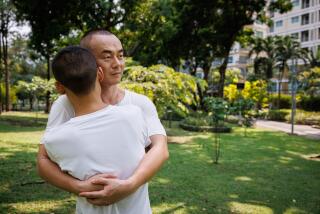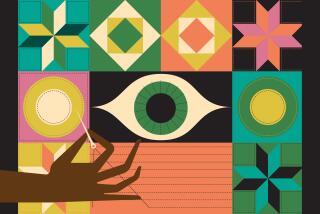In Thailand, Rack After Rack of Dazzling Silks : Manufacture of the brilliant fabrics was almost extinct until an American showed them to the fashion world.
- Share via
BANGKOK, Thailand — If rubies, sapphires, amethysts and emeralds could be rendered into cloth, the fabric would look like Thai silk.
The distinctive fabric handwoven in Thailand has a luminous jewel-like quality--almost an ethereal radiance. It is more substantial to the touch than other silks and bears, upon close inspection, the individual irregularities consistent with any object crafted by hand. It is the rare tourist who leaves Thailand without at least a small scarf or necktie in this dazzling silk. And often, entire outfits are commissioned.
I started small. On my first trip to Thailand, more than a dozen years ago, I bought a scarf subtly checkered in shades of lemon and lime. Another time it was a blouse the color of a light garnet. I had it made in a basement shop of the Dusit Thani hotel. This last time, in March, I binged, and ordered a jacket of heavy slubbed silk with the heft of a British tweed in emerald with threads of teal woven into the fabric. I chose teal for coordinated silk slacks and matching belt, then splashed the outfit with a lustrous purple blouse. The beauty of the fabric inspires such flights of fashion license.
It is almost impossible to avoid the silk. It’s practically a conspiracy. The looms, the shops are everywhere. In Chiang Mai, in northern Thailand, I once watched a woman spinning the precious thread from a pot of simmering silkworm cocoons--not a pretty sight, but fascinating. It made me wonder who first figured out that something so magnificent could be urged from something so creepy-crawly? Silk history does not answer that particular question, although we do know that the Chinese were the first to use silk, probably around 2700 BC. We also know that silk weaving has been a part of Thai history from the earliest times. As in many areas of Asia and the Pacific, the beliefs, tastes and attitudes of Thailand’s different ethnic groups, classes and geographic regions were reflected in their textiles, in the weaving techniques, patterns and colors. Simple weaving tools uncovered at archeological sites at Ban Chiang, in northeastern Thailand, indicate that the Thais have been using silk cloth for many thousands of years.
Mut-mee silk is one of the most ancient cloths in the world. Interestingly, it bears a strong resemblance to ancient cloth designs found in Russia. It is the pattern and dying process that distinguishes mut-mee from other Thai silks. In making mut-mee, the silk threads are tied according to the desired pattern before they are dyed, then the desired colors are dabbed onto the threads and left to dry before winding them onto bobbins. Only filaments uniform in size and texture are used. The designs are usually modeled after nature and represent such things as birds, serpents, flowers or ocean waves in geometric interpretations.
The man credited with bringing Thai silk to the attention of the world and reviving the fraying art is the late American architect Jim Thompson, who arrived in Thailand in 1945 as an intelligence agent and member of the American armed forces. Thompson was drawn to Thai arts, particularly the shimmering silk fabrics he would come across from time to time. At the time, there were only a few families left still hand-weaving silk in the traditional way. Thais had begun to look upon the fabric as too expensive and not in step with modern fashion notions.
Thompson changed all that. He persuaded a weaver whose family had been making traditional Thai silk for generations, and who was working as a plumber to make ends meet, to create 100 yards of silk in typical dazzling colors and patterns. Thompson packed up the yardage and headed for New York. An old friend, Frank Crowinshield, a former editor of Vanity Fair magazine, introduced him to the reigning arbiter of fashion, Edna Woolman Chase, then editor of Vogue. Chase fell in love with the glowing silk, phoned dress designer Valentina, persuaded her to create something in this new discovery and photographed the designer wearing her Thai silk dress for the pages of Vogue. Thai silk was launched.
From its beginning in 1948, Thompson Silk company was owned by Thai nationals. By 1967 it had expanded from that first part-time plumber weaving a few lengths of fabric to a company that kept 2,000 weavers busy on 500 looms. And even though Thompson disappeared that same year while on vacation in the mountainous jungle of central Malaysia (no trace of him has ever been found), the Jim Thompson Thai Silk Company continued to prosper and today it is the leader in what has become a major Thai industry.
Thompson’s home has become a museum. Admission fees go to the charities of the James H.W. Thompson Foundation. It is there that a quest for Thai silk is best begun.
Built in a lush garden on one of the city’s remaining klongs (canals), the house is actually a composition of six traditional Thai teak buildings, each more than two centuries old, as expertly woven together as threads of silk.
The main store of the Jim Thompson Thai Silk Company is a short taxi ride from the house. It is a kaleidoscope of brilliant hues--a jumbo crayon box of colors with tiers of fabric bolts in lustrous solids, audacious plaids and stripes and bold, clean prints. The ready-to-wear is executed in classic lines that will hold up for decades. This is considered to be top of the line, and is priced accordingly. Silk pillow shams will run $35, a scarf, $30, and fabric costs from $20 to $25 a yard. A set of eight heavy silk place mats with matching napkins would be $175; a simple, tailored dress $185.
Choisy, a shop next door, is owned by Germaine Pholabun, a Parisian married to a Thai. Her creations have an unmistakable French flair. She uses Thompson’s silk. A pair of wide palazzo pants would be $140, a cocktail dress $180, a magnificent evening dress, $240 to $320.
American friends living in Bangkok took me to two additional shops. One--the H.M. Factory--sells only silk yardage, for both fashion and interior design. Local people purchase the exceptionally fine fabric and take it to their own tailors. On most days, weavers will be busy making mut-mee silk, a specialty of the store.
Yet it doesn’t take “insider” knowledge or even much effort to find Thai silk. In Bangkok there are shops in just about every hotel and on every street selling yardage, ready-to-wear dresses, bomber jackets, blazers and inexpensive souvenirs, such as scarves, neckties, coin purses, eyeglass cases and picture frames. Many of the shops will do custom orders in 24 hours. The River City shopping center, next to the Bangkok Sheridan, had a number of reasonably priced shops also offering tailoring services. It’s a good idea to bring a favorite outfit from home or a pattern or sketch to be copied in Thai silk.
But the store that was my downfall was S.S. Thai Silk. It was here that I succumbed to my custom clothing and wrote out my traveler’s checks for $200. It fits beautifully. I feel like a queen. The only problem is, it’s so lovely I haven’t worn it because no occasion yet seems worthy.
I guess we’ll just have to go back to Thailand where even the waitresses in hotel coffee shops dress in silk splendor.
GUIDEBOOK: Buying Thai Silk
There are hundreds of shops selling Thai silk, many of which will fill custom orders overnight. To be sure of quality, be sure the shop is a member of the Thai Silk Assn., which is under the supervision of Thailand’s Office of Commodity Standards.
Jim Thompson Thai House, 6 Soi Kasemsan 2, Rama I Road, Bangkok, open daily except Sunday, 9 a.m. to 4:30 p.m.; telephone locally 215-012.
Jim Thompson Thai Silk Co., 9 Surawong Road, Bangkok; 234-4900.
Choisy, 9/25 Surawong Road, Bangkok; 233-779.
H.M. Factory Thai Silk, 43 Prom Chai Prom Pongse (Sukhumvit 39), Bangkok; 258-8766.
S.S. Thai Silk, second floor of Ammarin Plaza Shopping Center, next to the big, new Hyatt Erawan at 494 Rajdauri Road, Bangkok; 256-9023.
Caring for Thai silk: Jim Thompson Thai Silk recommends dry cleaning or washing with Woolite. S.S. Thai Silk recommends dry cleaning or washing with mild soap in tepid water and adding a spoon of clear, white vinegar to the last rinse to retain the original luster. Both companies stress not putting silk in the washing machine or wringing the fabric. They recommend drying it in the shade and ironing on the wrong side while still damp. My own method is to wash it in tepid water using the same shampoo I use on my hair, and adding cream rinse to the rinse water. While still damp, it irons like easy-care.
For more information: Contact the Tourism Authority of Thailand, 3440 Wilshire Blvd., Suite 1101, Los Angeles 90010, (213) 382-2353.






